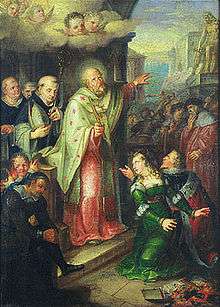Christianization of Bohemia

The Christianization of Bohemia refers to the spread of the Christian religion in the lands of medieval Bohemia.[1] As in many other countries, Christianity was related to the establishment of a new state (first the Duchy of Bohemia, later the Kingdom of Bohemia), and was implemented from the top down.[1]
The process began with the conversion of Bořivoj I, Duke of Bohemia, the founder of the Přemyslid dynasty, in 884.[1] It was an outgrowth of the Christianization of Moravia, traditionally attributed to the Greek missionaries, Saints Cyril and Methodius, in 863.[2] At first, the Christian rite in Bohemia was the Slavic one of the Eastern Orthodox Church, but it was soon replaced by the Roman Catholic rite, introduced due to Western influences, and also tensions between the Bohemians and the Moravians.[1][3] In 895, Prague became part of the Bavarian Roman Catholic Diocese of Regensburg.[1] In 973 a bishopric was established in Prague.[3][4]
By the 10th century, several native saints emerged in Bohemia: Saint Ludmila of Bohemia (wife of Bořivoj I), their grandson Saint Wenceslas and Saint Adalbert, Bishop of Prague.[5] Saint Wenceslas is said to have completed the Christianization of Bohemia in the early 10th century, shortly before his assassination in 935 by his own brother, Boleslav the Cruel.[2] Boleslav's daughter, Dobrawa of Bohemia, married Mieszko I of Poland, and became instrumental in converting him, his court, and Poland itself to the Christian religion.[6][7]
By the early 11th century, Bohemia gained an upper hand over Moravia, which was annexed to Bohemia.[3] Moravians were allowed to practice their Slavic Orthodox rites, but eventually they were replaced by Franco-Latin Catholic practices.[1] A parish network was created around the 13th century.[1]
See also
References
- 1 2 3 4 5 6 7 Carl Waldman; Catherine Mason (2006). Encyclopedia of European Peoples. Infobase Publishing. p. 200. ISBN 978-1-4381-2918-1. Retrieved 14 June 2013.
- 1 2 James Minahan (1 January 2000). One Europe, Many Nations: A Historical Dictionary of European National Groups. Greenwood Publishing Group. p. 201. ISBN 978-0-313-30984-7. Retrieved 14 June 2013.
- 1 2 3 Nora Berend (22 November 2007). Christianization and the Rise of Christian Monarchy: Scandinavia, Central Europe and Rus' C.900-1200. Cambridge University Press. p. 251. ISBN 978-1-139-46836-7. Retrieved 14 June 2013.
- ↑ International Commission for a History of the Scientific and Cultural Development of Mankind; Gaston Wiet (1975). History of Mankind: The great medieval civilizations (2 v. in 4). George Allen and Unwin. p. 193. Retrieved 14 June 2013.
- ↑ Laurence Cole; Daniel L. Unowsky (2007). The Limits of Loyalty: Imperial Symbolism, Popular Allegiances and State Patriotismin in the Late Habsburg Monarchy. Berghahn Books. p. 19. ISBN 978-1-84545-202-5. Retrieved 14 June 2013.
- ↑ Halina Lerski (30 January 1996). Historical Dictionary of Poland, 966–1945. ABC-CLIO. pp. 104–105. ISBN 978-0-313-03456-5. Retrieved 5 April 2012.
- ↑ Halina Lerski (30 January 1996). Historical Dictionary of Poland, 966–1945. ABC-CLIO. p. 27. ISBN 978-0-313-03456-5. Retrieved 5 April 2012.
